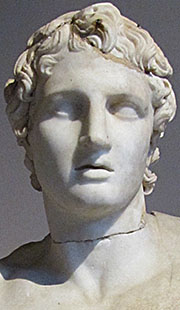A chance find from Giannitsa, near Pella. End of 4th century BC, early Hellenistic period. Height 30 cm.
Pella Archaeological Museum. Inv. No. ΓΛ 15.
Pella's most famous native, Alexandros III of Macedonia (Ἀλέξανδρος ὁ Μέγας, Alexandros o Megas, Alexander the Great, 356-323 BC), son of Philip II of Macedonia (382-336 BC).
This head, found at the nearby town of Giannitsa, is one of many Hellenistic copies of Alexander's official portraits made during and after his lifetime throughout his empire and the Greek world. The typical idealized portait of Alexander shows the young king with long wavy hair, his head slightly titled to the left, lips slightly parted and his gaze direct. This style of sculpture had a great influence on art, and many of his successors copied it for their official portraits and monuments, a tradition which continued with Roman emperors. (See also the portrait head of Attalus I of Pergamon.)
Alexander is said to have taken great care in choosing artists to portray him and deciding how he should be represented. Apart from the type of portrait above, the original of which is thought to be by his personal sculptor Lysippos, he was also shown in sculpture and coins in the guise of a god such as Herakles (see photos below right), Ammon or Pan to ascert his claims to divine descent.
The famous conquerer hero was greatly revered throughout the Hellenic and Roman world for centuries after his death, and statues of Alexander were made as copies, and copies of copies of originals. As with his portrait on coins, later sculptures bore little resemblance to the originals and often reflect contempory local tastes (see the Alexander the Great page of the MFP People section).
Many of the original sculptures of Alexander were made in bronze, though until now no complete bronze statues of him have been unearthed. However, in February 2010 Greek authorities arrested two men accused of illegally possessing antiquities, including a bronze statuette of Alexander. Experts and the press becme very excited about the possibility that it could be an original work of Lysippos, and it was taken to the laboratory of the Thessaloniki Archaeological Museum for examination. If the piece is authentic, it would be the only original work by Lysippos and the first complete bronze of Alexander yet discovered.
See also statues of Alexander and Hephaistion
from Alexandria, Egypt on gallery page 17. |

Alexander the Great.
Detail of a life-size marble
statue, signed by Menas.
From Magnesia ad Sipylum,
Lydia (Manisa, Turkey).
Mid 3rd century BC.
Istanbul Archaeological
Museum. Inv. No. 709.
Cat. Mendel 536. |
|